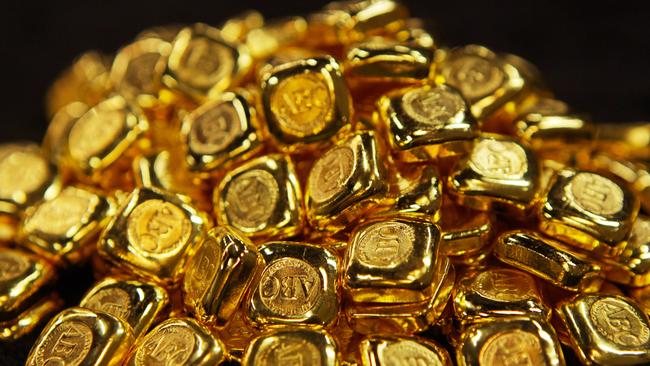Gold not always a safe bet, despite Peter J. August’s glowing opinion
With another global financial crisis due soon, is gold really a safe bet for investors?

Why Gold Matters, by Melbourne Mint chief executive Peter J. August, is an interesting book that profiles a range of historical crises in economies and markets, and sets out a case for multiple sources of calamities in the future.
I have great sympathy for such efforts. First, because about every seven to 10 years since the 1960s we have seen a global financial crisis. The next one is due soon. Second, because there is no way to avoid the next crunch.
Regulators simply are unable to predict their occurrence and identify developments in real time. And there are no sanctions for the senior executives — especially in financial institutions — who bring us the crises. August is correct: “Leaving those who acted as vectors of the financial plague to engineer new solutions is folly.”
The first chapter is an interesting introduction to gold, particularly its place in ancient times and passage to diverse uses as coinage and in industry. Chapter two is a review of the evils of inflation, illustrated by photos of a Zimbabwean $100 trillion note and a wheelbarrow of German cash required to buy a loaf of bread in 1923.
After the history lesson, the meat of the book sets out factors in modern economies that could trigger future crises. The language turns lyrical: “The GFC was the product of a diabolical union. For years, politicians and bankers had been hooking up like libidinous revellers at a swingers’ bacchanal.”
With this head of steam, the book rips into the risks posed from the hoarding of gold by Asian investors; banking’s business model where less than 10 per cent of deposits and loans to banks are backed by cash; manipulation of gold prices through derivatives; chronic warfare and disruptions to oil supply; and continuing debt and currency volatility.
Although this detail is interesting, its authority is undermined by the lack of an index, and only 18 references in the bibliography, with a few others noted in the text. Nor is credibility helped by errors of fact. August writes that “the financial crisis that followed the collapse of legendary US investment banking firm Lehman Brothers in 2008 put a rocket under the gold price”. In fact, on the Friday before Lehman’s weekend collapse, gold closed at $US758 an ounce; two months later it was down 7 per cent to $US732. At another point: “The backing of the federal government and Reserve Bank preserved the [Australian] banks’ triple-A credit rating.” Of course, they are rated only double-A or lower.
The intent of this background seems to be to set out conditions that are leading inexorably to global economic malaise and erupting inflation. At such a time, “only gold and silver can possibly endure, and only those who own the precious metals will preserve their wealth”. The rationale is gold and silver are safe havens for investors in times of crisis because their value endures when paper currency, shares and so on collapse. August argues: “Gold is the ultimate zero-risk investment during times of fear and uncertainty.” Gold is “an investor’s go-to commodity when other instruments of exchange, other stores of wealth, are in doubt”. This leads to his closing paragraph: “Given the clear and present threat of systemic failure, only gold and silver … offer a genuine haven in the event of a crisis … That is why gold and silver matter.”
This highlights the main weakness of the book: it merely asserts that gold can protect investors against the many threats to their wealth. This assertion is neither tested nor proven. Ideally one would like to see a chart of the gold price, and boxes pointing to events that triggered its rise or where the price held up in real terms while the value of other assets collapsed. Such a chart does not exist because gold does not provide the claimed protection.
Certainly there are examples of market collapses where the price of gold held up. For instance, August correctly points out that the Lehman Brothers bankruptcy was the US’s largest and “destroyed the already shaky confidence investors had in the world’s premier financial institutions”. The US stockmarket fell by 32 per cent over the next two months. What happened to gold? As discussed earlier, in the wake of one of the globe’s most damaging financial events gold’s price wobbled down, too, although not by as much as shares.
But this is the exception rather than the rule. In fact a plot of the gold price and the US equity market shows gold often fails to provide protection against financial crises. And, of course, the circumstances the book advances as support for investing in gold have been true since 2011 when the gold price peaked and has fallen by a third.
Across the longer term gold has proven to be a below-average investment. Until 1971 gold’s price was pegged to the US dollar at an official rate of $US35 an ounce; once that was lifted the price jumped to about $US65 in 1973, and is about $1200 today. In the past 44 years, gold’s price rose 19-fold, or an average of about 6.9 per cent a year. During the same time the US S&P 500 rose 20-fold, or 7 per cent annually, to which should be added about 2 per cent in dividends. Even ultra-safe US Treasury bills returned almost 5 per cent a year.
It is fine to say in hindsight that gold could have provided protection, but calling the turn is difficult if not impossible. Moreover, every investor is aware of diversification, by which many asset classes move in different directions. Gold is not the only hedge against financial crises.
Gold is neither a good long-term investment nor a uniquely reliable store of wealth in periods of crisis. Unfortunately, facts belie the book’s conclusion: “If one thing shines through in this book, it is that gold and silver matter more than ever.”
Les Coleman is a finance academic at the University of Melbourne.
Why Gold Matters
By Peter J. August
Melbourne Mint, 187pp, $39.99 (HB)


